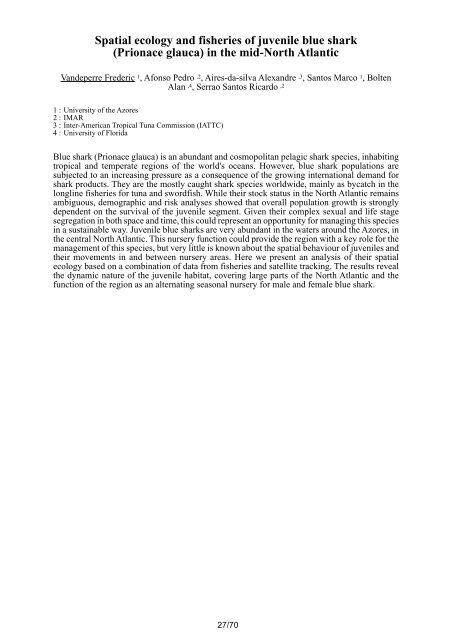Create successful ePaper yourself
Turn your PDF publications into a flip-book with our unique Google optimized e-Paper software.
Spatial ecology and fisheries <strong>of</strong> juvenile blue shark<br />
(Prionace glauca) in the mid-North Atlantic<br />
Vandeperre Frederic 1, Afonso Pedro ,2, Aires-da-silva Alexandre ,3, Santos Marco 1, Bolten<br />
Alan ,4, Serrao Santos Ricardo ,2<br />
1 : University <strong>of</strong> the Azores<br />
2 : IMAR<br />
3 : Inter-American Tropical Tuna Commission (IATTC)<br />
4 : University <strong>of</strong> Florida<br />
Blue shark (Prionace glauca) is an abundant and cosmopolitan pelagic shark species, inhabiting<br />
tropical and temperate regions <strong>of</strong> the world's oceans. However, blue shark populations are<br />
subjected to an increasing pressure as a consequence <strong>of</strong> the growing international demand for<br />
shark products. They are the mostly caught shark species worldwide, mainly as bycatch in the<br />
longline fisheries for tuna and swordfish. While their stock status in the North Atlantic remains<br />
ambiguous, demographic and risk analyses showed that overall population growth is strongly<br />
dependent on the survival <strong>of</strong> the juvenile segment. Given their complex sexual and life stage<br />
segregation in both space and time, this could represent an opportunity for managing this species<br />
in a sustainable way. Juvenile blue sharks are very abundant in the waters around the Azores, in<br />
the central North Atlantic. This nursery function could provide the region with a key role for the<br />
management <strong>of</strong> this species, but very little is known about the spatial behaviour <strong>of</strong> juveniles and<br />
their movements in and between nursery areas. Here we present an analysis <strong>of</strong> their spatial<br />
ecology based on a combination <strong>of</strong> data from fisheries and satellite tracking. The results reveal<br />
the dynamic nature <strong>of</strong> the juvenile habitat, covering large parts <strong>of</strong> the North Atlantic and the<br />
function <strong>of</strong> the region as an alternating seasonal nursery for male and female blue shark.<br />
27/70




